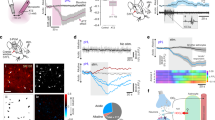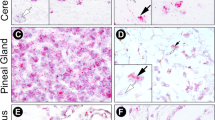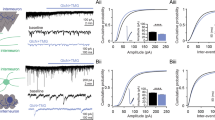Abstract
APART from the dicarboxylic acids, taurine is the most abundant amino-acid in the nervous system1, and yet very little is known about its function2. It has been suggested that taurine acts as a transmitter; Curtis and Watkins3 have evidence that among other amino-acids, taurine when applied iontophoretically to the vicinity of a neurone in the central nervous system exerts an inhibitory effect on the rate of firing and, furthermore, there is a structural resemblance between γ-aminobutyric acid (GABA) and taurine. There are also similarities in the distribution of both these amino-acids and in the localization of their synthesizing enzymes in different regions of the brain4. In addition, after density gradient centrifugation of rat brain homogenate, both cysteinesulphinate decarboxylase activity and taurine has been found to be enriched in the nerve ending fractions4. Glutamate and cysteinesulphinate decarboxylases are closely similar enzymes5 and their activities increase in parallel during development of rat brain4.
This is a preview of subscription content, access via your institution
Access options
Subscribe to this journal
Receive 51 print issues and online access
$199.00 per year
only $3.90 per issue
Buy this article
- Purchase on Springer Link
- Instant access to full article PDF
Prices may be subject to local taxes which are calculated during checkout
Similar content being viewed by others
References
Agrawal, H. C., Davies, J. M., and Himwich, W. A., J. Neurochem., 13, 607 (1966).
Gaitonde, M. K., in Handbook of Neurochemistry (edit. by Lajtha, A.), 3, 225, (Plenum Press, New York, 1970).
Curtis, D. R., and Watkins, J. C., Pharmacol Rev., 17, 347 (1965).
Agrawal, H. C., Davison, A. N., and Kaczmarek, L. K., Biochem. J., 122, 759 (1971).
Davison, A. N., Biochim. Biophys. Acta, 19, 66 (1956).
Srinivasan, V., Neal, M. J., and Mitchell, J. F., J. Neurochem., 16, 1235 (1969).
Peck, E. J., and Awapara, J., Biochim. Biophys. Acta, 141, 499 (1967).
Iversen, L. L., and Neal, M. J., J. Neurochem., 15, 1141 (1968).
Author information
Authors and Affiliations
Rights and permissions
About this article
Cite this article
DAVISON, A., KACZMAREK, L. Taurine—a Possible Neurotransmitter ?. Nature 234, 107–108 (1971). https://doi.org/10.1038/234107a0
Received:
Revised:
Issue Date:
DOI: https://doi.org/10.1038/234107a0
This article is cited by
-
Metabolomics approach revealed robust changes in amino acid and biogenic amine signatures in patients with schizophrenia in the early course of the disease
Scientific Reports (2020)
-
Synthesis, Fungicidal Activity, and Structure Activity Relationship of β-Acylaminocycloalkylsulfonamides against Botrytis cinerea
Scientific Reports (2017)
-
Taurine and central nervous system disorders
Amino Acids (2014)
-
Kainic acid (KA)-induced seizures in Sprague-Dawley rats and the effect of dietary taurine (TAU) supplementation or deficiency
Amino Acids (1999)
-
In vivo release patterns and cardiovascular properties of inhibitory and excitatory amino acids in the hypothalamus
Amino Acids (1995)
Comments
By submitting a comment you agree to abide by our Terms and Community Guidelines. If you find something abusive or that does not comply with our terms or guidelines please flag it as inappropriate.



